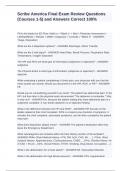Scribe America Final Exam Review Questions
(Courses 1-5) and Answers Correct 100%
Fill in the blanks for ED Flow: Walk in > *Blank 1* > Bed > Physician Assessment >
Lab/Rad/Meds > Results > MDM > Diagnosis > Consults > *Blank 2* - ANSWER-
Triage, Disposition
What are the 3 disposition options? - ANSWER-Discharge, Admit, Transfer
What are the 5 vital signs? - ANSWER-Heart Rate, Blood Pressure, Respiratory Rate,
Temperature, Oxygen Saturation
The HPI and ROS are what type of information (subjective or objective)? - ANSWER-
subjective
The Physical Exam is what type of information (subjective or objective)? - ANSWER-
objective
While evaluating a patient complaining of chest pain, your physician tells you that the
heart sounds are normal. Would you document it in the HPI, ROS, or PE? - ANSWER-
PE
Would you be contradicting yourself if you wrote "The patient has abdominal pain" in the
HPI, but then later in the physical exam documented "The abdomen is nontender." Why
or why not? - ANSWER-No, because the patient stating they have abdominal pain is a
subjective complaint. A non-tender abdomen is an objective finding.
What is the difference between the HPI and ROS? - ANSWER-HPI focuses on the
details related to their chief complaint. ROS is a head-to-toe checklist of symptoms. It
includes the chief complaint, associated symptoms, and all other complaints the patient
may have.
What does disposition (dispo) mean? - ANSWER-The patient's destination after they
leave the Emergency Department.
What subcategories are included within the Past History section of the template? -
ANSWER-PMHx (Past Medical History- HTN, DM, HLD, CAD, MI.......), PSHx, (Past
Surgical History- Appendectomy, Cholecystectomy, CABG......)FHx, (Family History- Hx
of CAD < 55 y/o....)SHx, (Social History- ETOH, Smoking, Drug Abuse, Occupation.....)
What is the abbreviation for a heart attack? - ANSWER-MI- Myocardial Infarction
What is the abbreviation for high blood pressure? - ANSWER-HTN- Hypertension
, What is the medical term for acid reflux? - ANSWER-GERD- Gastroesophageal Reflux
Disease
What is the medical term for stroke? - ANSWER-CVA- Cerebrovascular Accident
What is the term for gallbladder removal? - ANSWER-Cholecystectomy
What does NKDA stand for? - ANSWER-No Known Drug Allergies
What is the medical term for redness? - ANSWER-Erythema
What is the medical term for bruising? - ANSWER-Ecchymosis
If the doctor says the exam was "benign", what does that mean? - ANSWER-Normal-
Nothing of concern
What is CAD? - ANSWER-Coronary Artery Disease.
What other past histories would suggest that a patient has CAD? - ANSWER-MI,
Angina, CABG, Stent, Angioplasty
Does a PMHx of CVA mean the patient has CAD? - ANSWER-No
Does a surgical history of angioplasty mean the patient has CAD? - ANSWER-Yes
Explain the difference between CAD and an MI. - ANSWER-CAD is a broad term for
heart disease. MI is included in CAD. It's an active heart attack.
If someone has a PMHx of A - ANSWER-Fib or CHF, do they also have CAD?- No
What are the "cardiac risk factors?" - ANSWER-HTN, DM, HLD, CAD, Smoking, FHx
CAD < 55 y/o
How is CAD diagnosed? - ANSWER-By a cardiologist during a cardiac catheterization.
Not done in the ED.
Name two ways that an MI can be diagnosed? - ANSWER-STEMI- EKG, Non-STEMI-
Troponin
What are some associated symptoms of an MI other than CP? - ANSWER-N/V, SOB,
Diaphoresis
What are some associated symptoms for CHF? - ANSWER-SOB (Orthopnea, PND,
DOE), pedal edema
What 2 studies would diagnose CHF? - ANSWER-CXR or elevated BNP




